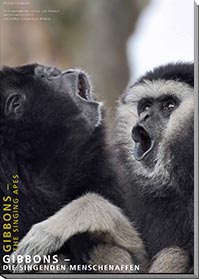
Download PDF (11.6 MB)
|
The
conservation status
of hoolock gibbons in Myanmar
2013
by Thomas Geissmann, Mark E. Grindley, Ngwe Lwin, Saw Soe Aung, Thet
Naing Aung, Saw Blaw Htoo, and Frank Momberg (Authors)
Electronic Edition: xii +
157 pages
Publisher: Gibbon
Conservation Alliance,
Zurich, Switzerland
Language: English
ISBN: 978-3-033-04358-9
From the Back Cover:
Hoolock
gibbons are small apes of South-east Asia, and
Myanmar is believed to be their last stronghold. In Bangladesh, India,
and China, most forests supporting the hoolock gibbons are small and
highly fragmented. Myanmar, in contrast, is thought to have huge areas
of hoolock gibbon habitat in good quality and to hold significant
populations of both the western and the eastern hoolock gibbon. This
report takes the first detailed look at the status of each Myanmar’s
hoolock species.
Until now,
conservation actions for the hoolock gibbons in
Myanmar were constrained by a lack of data on their distribution,
population size and threats. We addressed this need by conducting a
nationwide review of the status of the species based on: (1) a review
of the taxonomic and ecological knowledge on both hoolock species
throughout their range, (2) a compilation of a full annotated list of
hoolock records, published and unpublished, for Myanmar, and (3)
population estimates and threats assessments for both species
throughout Myanmar based on various field surveys conducted by the
authors for this project.
The
resulting report gives a first picture of the
conservation status of Myanmar’s hoolock gibbons in a regional,
national and international context.
|

Download PDF (6 MB)
|
Gibbons
– The singing apes
Gibbons – Die
singenden Menschenaffen
2014
by Thomas Geissmann (Author)
Softcover Edition: 48
pages
Publisher:
Anthropologisches Institut und Museum Universität Zürich, and Gibbon
Conservation Alliance,
Zurich, Switzerland
Language: English and
German
ISBN: 978-3-033-04475-3
Accompanying booklet to an exhibit at the Museum of Anthropology,
University of Zurich, Switzerland.
From the Introduction:
Gibbons are apes. They are more closely related to humans than to
macaques, baboons or langurs. Yet, these small apes are far less known
and researched than their larger relatives (chimpanzees, gorillas or
orangutans).
Gibbons are unique among the apes in many respects, for example in
their social life, locomotion, anatomy or their way of communication.
Gibbons live in small family groups consisting of one to six animals. This type of social
structure can only be found in
approximately 3% of all mammals. Gibbons live in the tropical
rainforests of Southeast Asia. With their lightweight physique they are
adapted to life in the treetops and with their long arms they move
acrobatically in brachiation, a unique way of locomotion that is
repeatedly being compared to bird flight. Whether on the ground or on
thick branches, gibbons do not walk on all fours like most monkeys and
apes; they walk upright like humans.
The territorial morning songs of the gibbons are among the most
spectacular calls of all mammals. They are often performed as carefully
matched duet songs by mated gibbon pairs. Gibbon songs are considered
to be the best model for the evolution of human music.
Gibbons are the first apes to which humans developed a close
relationship. For more than 2000 years, gibbons have been of particular
importance in Chinese culture, where they represent the fabled link
between humans and nature and where they are a symbol of eternal life,
among other things. They have been the object of worship in numerous
paintings and poems.
Today many gibbons are extremely threatened to the point of extinction.
Among them we find the rarest apes and, furthermore, even the rarest
species of primates. The biggest threats are habitat loss and
degradation, hunting and illegal trade. Conserving the gibbons must
become a top priority.
|



